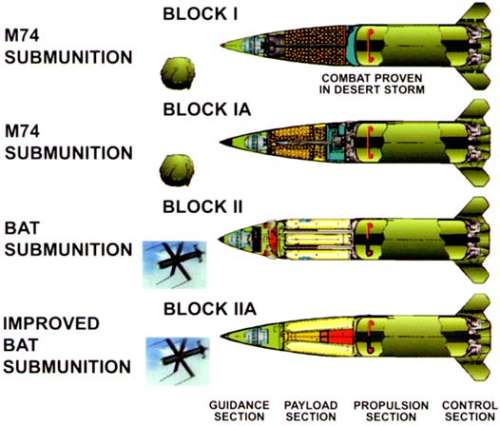Lockheed Martin MGM-164 ATACMS II
The MGM-164 ATACMS Block II was a derivative of the MGM-140 ATACMS (Army Tactical Missile System). The Block II designation applied to ATACMS variants designed to deliver the BAT (Brilliant Anti-Tank) guided submunition.
As early as 1991, a Block II version of ATACMS was planned, which was to carry the Northrop Grumman BAT guided submunition. BAT was originally planned as the munition for the MGM-137B, the U.S. Army's version of the TSSAM (Tri-Service Standoff Attack Missile), which was cancelled in early 1993. The first flight of a modified ATACMS with BAT submunitions occurred in 1995, and the first flight of a proper ATACMS Block II, then designated MGM-140C, succeeded in 1996. Since then the major test and development effort had been to make BAT a reliable submunition. In December 2000, the designation MGM-164A was assigned to the production version of the ATACMS Block II, which was to include technology from the so-called "TACMS 2000" (T2K) program. TACMS 2000, funded by Lockheed Martin and the U.S. Army, was designed to reduce production costs for all ATACMS missiles, and Lockheed Martin claims to have reduced the cost per missile by up to US$ 100000. A contract for low-rate initial production of the ATACMS Block II was finally awarded to Lockheed Martin in August 2001, and the first all-T2K configured MGM-164A flight test succeeded in August 2002. At that time, initial operational capability was planned for early 2003. However, in late 2003 the Army terminated the funding for the BAT-equipped ATACMS, and therefore the MGM-164A never became fully operational. The status of the existing LRIP missiles is unclear, but it is possible that at least some of the missiles will be converted to unitary warheads and the BAT submunitions to GBU-44/B Viper Strike rounds.
The MGM-164A had the same inertial/GPS guidance system as the MGM-140B. It carried 13 BAT submunitions in the enlarged warhead section, and range was about 140 km (87 miles). Once released, the BAT used passive acoustic wingtip sensors for initial target acquisition, and an IIR (Imaging Infrared) sensor for terminal guidance.
 |
 | |
| Photo: Lockheed Martin | Photo: Raytheon | |
| MGM-140C (MGM-164A) | BAT |
The ATACMS Block IIA was an improved Block II, carrying 6 IBAT (Improved BAT) submunitions, also known as P3I BAT (Pre-Planned Product Improvement BAT), over a range of 300 km. Development of this variant was also terminated in late 2003.
 |
| Image: Lockheed Martin |
| MGM-140 / MGM-164 ATACMS variants |
Specifications
Note: Data given by several sources show slight variations. Figures given below may therefore be inaccurate!
Data for MGM-164A:
| Length | 4.0 m (13 ft) |
| Diameter | 0.61 m (24 in) |
| Finspan | 1.4 m (55 in) |
| Weight | 1480 kg (3270 lb) |
| Ceiling | > 50 km (30 miles) |
| Range | 140 km (87 miles) |
| Propulsion | Solid-fueled rocket |
| Warhead | 268 kg (592 lb) (13 BAT submunitions) |
Main Sources
[1] Hajime Ozu: "Missile 2000 - Reference Guide to World Missile Systems", Shinkigensha, 2000
[2] Redstone Arsenal Historical Information Website
[3] Lockheed Martin Missiles and Fire Control Website
[4] Department of Defense Missile Nomenclature Records
Back to Current Designations Of U.S. Unmanned Military Aerospace Vehicles
Back to Directory of U.S. Military Rockets and Missiles
Last Updated: 19 September 2006